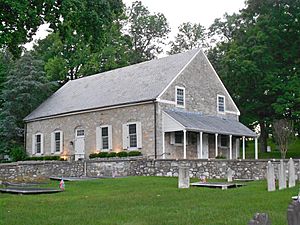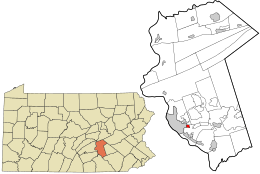Paxtang, Pennsylvania facts for kids
Quick facts for kids
Paxtang, Pennsylvania
|
|
|---|---|
|
Borough
|
|

Paxtang Presbyterian Church
|
|

Location in Dauphin County and the U.S. state of Pennsylvania.
|
|
| Country | United States |
| State | Pennsylvania |
| County | Dauphin |
| Settled | 1722 |
| Incorporated | 1914 |
| Government | |
| • Type | Borough Council |
| Area | |
| • Total | 0.41 sq mi (1.05 km2) |
| • Land | 0.41 sq mi (1.05 km2) |
| • Water | 0.00 sq mi (0.00 km2) |
| Elevation | 371 ft (113 m) |
| Population
(2020)
|
|
| • Total | 1,648 |
| • Density | 4,059.11/sq mi (1,567.86/km2) |
| Time zone | UTC-5 (Eastern (EST)) |
| • Summer (DST) | UTC-4 (EDT) |
| ZIP code |
17111
|
| Area code(s) | 717 |
| FIPS code | 42-58504 |
Paxtang is a small town, called a borough, in Dauphin County, Pennsylvania, United States. In 2020, about 1,640 people lived there. Paxtang is a close neighbor, or suburb, of Harrisburg. It is one of the very first settlements built by European colonists in South Central Pennsylvania.
Contents
History of Paxtang
Paxtang's story began in the 1700s. At that time, European settlers arrived where the Shawnee and Lenape Native American tribes had a village called Peshtank. The Lenape word Peshtank means "where the waters stand." Over time, this name changed to Paxtang or Paxton. This area was important because the Susquehanna River was easy to cross here. This made Paxtang a great spot for people and trade goods to move across the river.
In 1700, William Penn, who founded the Pennsylvania Colony, bought land in the Susquehanna Valley from the Susquehannock people. This agreement was confirmed by a treaty in 1701. Later, in 1714, a French fur trader named Peter Bisaillon was given 250 acres of land near Peshtank. He was allowed to build what he needed for his trading business.
Paxtang is also known for a difficult event in history. A group of Scotch-Irish frontiersmen, known as the Paxton Boys, formed a vigilante group. This group attacked the Susquehannock people in what is known as the Conestoga Massacre. On December 14, 1763, more than 50 Paxton Boys attacked a settlement near Millersville, Pennsylvania. They killed six people and burned their homes. Pennsylvania authorities tried to protect the remaining fourteen Susquehannock people by moving them to Lancaster. However, the Paxton Boys broke in and killed all fourteen on December 27, 1763.
A month before this, 140 Moravian Lenape and Mohican people, who lived peacefully in eastern Pennsylvania, were moved to Philadelphia for their safety. In February 1764, the Paxton Boys marched towards Philadelphia with hundreds of followers. However, they stopped and went home after talking with a group led by Benjamin Franklin.
Old Paxton Church: A Historic Landmark
Paxtang is home to the Old Paxton Church, one of the oldest churches in the area. Built in 1740, this church is the oldest Presbyterian Church building in Pennsylvania that has been used continuously. It is also the second oldest in the entire United States. In 1726, Rev. James Anderson became the first regular preacher here. The church's history is closely tied to the history of central colonial Pennsylvania.
In 1732, the church officially became a Presbyterian Church. Rev. William Bertram was its first official pastor. In 1738, Rev. John Elder, known as the "Fighting Parson," became the pastor. He served during the French and Indian War and the Revolutionary War, even serving as an officer. Many of the church's pastors have served for a very long time. For example, four ministers together served for 140 years!
The church building you see today, made of stone, was built in 1740. It replaced an older log building that was used for worship. A stone marker south of the church shows where the old log building stood. A copy of the log meeting house was built north of the current church.
Next to the church is a historic cemetery. Many important people are buried here. These include soldiers from the French and Indian War, the Revolutionary War, the Civil War, and both World Wars. People who helped shape early America, like John Harris Jr. and William Maclay (Pennsylvania's first U.S. senator), are also buried here. Four of the six people who planned the town of Harrisburg in 1785 are also laid to rest in this cemetery. Ministers, lawmakers, farmers, teachers, and even enslaved African Americans are buried in this historic place.
Geography of Paxtang
Paxtang is located in the southern part of Dauphin County. It is next to the city of Harrisburg on its western side.
The United States Census Bureau says that Paxtang covers about 1.05 square kilometers (or 0.41 square miles) of land. There is no water area within the borough.
Paxtang Park is located along the border with Harrisburg. It is a starting point for the Capital Area Greenbelt, which is a popular trail for walking and biking.
Population and People
| Historical population | |||
|---|---|---|---|
| Census | Pop. | %± | |
| 1920 | 822 | — | |
| 1930 | 1,594 | 93.9% | |
| 1940 | 1,707 | 7.1% | |
| 1950 | 1,857 | 8.8% | |
| 1960 | 1,916 | 3.2% | |
| 1970 | 2,039 | 6.4% | |
| 1980 | 1,649 | −19.1% | |
| 1990 | 1,599 | −3.0% | |
| 2000 | 1,570 | −1.8% | |
| 2010 | 1,561 | −0.6% | |
| 2020 | 1,640 | 5.1% | |
| 2021 (est.) | 1,636 | 4.8% | |
| Sources: | |||
In 2010, there were 1,561 people living in Paxtang. These people lived in 660 households. About 31.7% of these households had children under 18 living with them. Many households were married couples living together. About 29.4% of all households were made up of people living alone.
The population of Paxtang is diverse. In 2010, about 79% of the people were White. About 10.6% were Black or African American. Around 9.1% were Hispanic or Latino. There were also people of Asian descent and those from two or more races.
The median age in Paxtang in 2000 was 39 years old. This means half the people were older than 39 and half were younger.
Education in Paxtang
Children who live in Paxtang attend public schools. These schools are part of the Central Dauphin School District.
See also
 In Spanish: Paxtang para niños
In Spanish: Paxtang para niños



